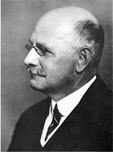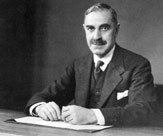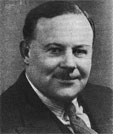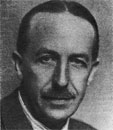
|
George HughesGeorge Hughes was born on 9 October 1865 in Benwick (Cambridgeshire Fens) and was the son of a farmer and miller. He was educated at County School at Elmham in Norfolk, and died in Stamford after spending much of his retirement in Cromer. In 1882 he became a premium apprentice at Crewe under F.W. Webb, and in 1887 he moved to the new LYR works at Horwich as a fitter and erector. In 1888 he took charge of the Testing Shop there, and by 1894 he was in charge of the Horwich gas works and lighting system. In the following year he became Chief Assistant in the Carriage and Wagon Department at Newton Heath, and returned to Horwich in 1899 as Works Manager and Principal Assistant to the CME. He succeeded H.A. Hoy as CME from 12 March 1904. Under his direction Horwich established a reputation for progressive locomotive engineering, particularly in the development of superheating. Equally there were developments in workshop techniques, directed at increasing the accuracy of manufacture and the interchangeability of parts. In May 1892 he married Ann Mary Young of Swaffham in Norfolk. From 1904, he is associated with the fitting of the first Schmidt high temperature superheaters in Britain, which he applied to two of his 0-6-0 locomotives in 1906. A student of compounding, he soon realized that Webb's compounds were only likely to produce economies in slow freight service, and built some 0-8-0 locomotives on the Webb four-cylinder system. But in a perceptive paper presented to the Institution of Mechanical Engineers in 1910 he argued that the fuel economy of his compounds was insufficient to outweigh the higher initial cost and extra maintenance expense. His four-cylinder simple 4-6-0 was at first a mediocre performer, but after the fitting of superheaters and redesign of steam passages its successors did quite well, and were arguably the most handsome machines of their time. Hughes was always willing to learn from foreign experience and but for WW1 would probably have built 2-10-0 locomotives to the general design of the Belgian Flamme. He adopted Flamme ideas in his dynamometer car which served the LMS and British Railways. On 1 January 1922, with the amalgamation of the LYR and LNWR, Hughes became CME of the greater LNWR, and in 1923 he became CME of the LMS, retaining his headquarters at Horwich. The main activity during his LMS regime at Horwich was the design of the 'Crab' 2-6-0, the detailed work on which was prolonged by the need to meet the requirements of the Civil Engineers of the constituent companies, which had differing loading gauges and weight restrictions. An ambitious scheme for a range of standard types from 0-6-0T to Pacific was prepared, but the slow progress of the 2-6-0 project retarded work on the other classes, and none was completed. The difficulties of working under conditions of grouping contributed to Hughes' retirement in September 1925, just before his sixtieth birthday. He retired to Cromer where he served on the Coastal Erosion Committee. His wife died in 1928, but he re-married in 1929. In 1940 he moved to Stamford where he died on 27 October 1945. He is buried in his birthplace. The obituary in The Engineer (2 November 1945, p.349) noted: he was a lovable, cheerful man. He did valuable work without any display, any push, and for that reason perhaps in a noisy world did not always receive the recognition he deserved. |

|
Sir Henry FowlerHenry Fowler was born in Evesham, Worcestershire, on 29 July 1870. His father, also called Henry was a furniture dealer, and his family were Quakers. He was educated at Prince Henry's High School, Evesham, and at Mason Science College, Birmingham between 1885 and 1887 where he studied metallurgy. He served an apprenticeship under John Aspinall at the Lancashire and Yorkshire Railway (L&YR)'s Horwich Works from 1887 to 1891. He then spent four years in the Testing Department under George Hughes, whom he succeeded as Head of the Department. Between 1895 and 1900 he was Gas Engineer of the L&YR, moving on 18 June 1900 to the Midland Railway (MR). On 1 November 1905 he became Assistant Works Manager, being promoted to Works Manager two years later. In 1909 he succeeded Richard Deeley as Chief Mechanical Engineer (CME) of the MR. Between 1915 and 1919 Fowler was employed on war work and James Anderson became acting CME. In 1919, Fowler was made a Knight Commander of the Order of the British Empire (KBE) for his contributions to the war effort. In 1923 on the Grouping, he was appointed deputy CME of the newly-formed London, Midland and Scottish Railway (LMS), under George Hughes and became CME in October 1925. Along with Anderson, Fowler was responsible for the adoption by the LMS of the Midland's small engine policy. Various Midland standard types were built by the LMS, including the 4P Midland Compound 4-4-0, the 2P 4-4-0, the 4F 0-6-0, and the 3F 0-6-0T. The small engine policy resulted in frequent double-heading, as the locomotives were not powerful enough to cope with loads, and thus increased expense. Standardisation also left these standard locomotives with short-travel valves and small axle boxes, the former leading to inefficiency and the latter to frequent hot axle boxes. Sir Henry retired in 1933 and died in 1938. |

|
Sir Ernest LemonErnest Lemon was educated at Heriot-Watt College. He served an apprenticeship with the North British Locomotive Company and then worked for the Highland Railway and for Hurst Nelson. In 1911 Lemon became Chief Wagon Inspector of the Midland Railway. In 1917 he was made Carriage Works Manager at Derby. In 1923 he was appointed Divisional Carriage and Wagon Superintendent at Derby. There he developed production line methods for the construction of wagons and carriages. Despite having little experience in locomotive engineering, in 1931 Lemon was appointed to the post of Chief Mechanical Engineer replacing the retiring Henry Fowler. After less than a year as CME however, Lemon was again promoted to Vice-President Railway Traffic, Operating and Commercial, replacing J.H. Follows who retired due to ill health. Under his Vice-Presidency, the LMS undertook modernisation of their motive power depots. William Stanier had been head-hunted from the Great Western Railway to replace him as CME and revolutionised the LMS's locomotive policy. He was a member of the Engineer and Railway Staff Corps - a Territorial Army unit of the Royal Engineers; he joined as a Major in November 1929, and was promoted to Lieutenant-Colonel in April 1932. He resigned his commission in August 1943. During the Second World War Lemon was made Director-General of Aircraft Production and received a knighthood in the 1941 New Year's Honours list. He retired from the railway in 1948 and died in Epsom in 1954. |

|
Sir William StanierWilliam Stanier was born in Swindon, where his father worked for the Great Western Railway (GWR) as William Dean's Chief Clerk, and educated at Swindon High School and also, for a single year, at Wycliffe College. In 1891 he followed his father into a career with the GWR, initially as an office boy and then for five years as an apprentice in the workshops. Between 1897 and 1900 he worked in the Drawing Office as a draughtsman, before becoming Inspector of Materials in 1900. In 1904, George Jackson Churchward appointed him as Assistant to the Divisional Locomotive Superintendent in London. In 1912 He returned to Swindon to become the Assistant Works Manager and in 1920 was promoted to the post of Works Manager. In late 1931, he was "headhunted" by Sir Josiah Stamp, chairman of the London, Midland and Scottish Railway (LMS) to become the Chief Mechanical Engineer (CME) of that railway from 1 January 1932. He was charged with introducing modern and more powerful locomotive designs, using his knowledge gained at Swindon with the GWR. Stanier built many other very successful designs for the LMS, especially the "Black 5" mixed traffic 4-6-0, and the 8F 2-8-0 freight locomotives. His Coronation Scot set a new British record of 114mph, beating the previous record set by a Gresley A4. During WWII he worked as a consultant for the Ministry of Supply and retired in 1944. He was knighted on 9 February 1943 and elected a Fellow of the Royal Society on his retirement. He was also president of the Institution of Mechanical Engineers for 1944. He died in Rickmansworth in 1965. He had married in 1906 Ella Elizabeth, daughter of C C Morse; they had one son and one daughter. |

|
Charles FairburnBorn in Bradford in 1887, Fairburn won a scholarship to Brasenose College, Oxford University, in 1905, gaining first class honours and being the first graduate to graduate from Oxford's new Engineering School. He then served two years under the tutelage of Henry Fowler at the Midland Railway. In 1912 Fairburn joined the Siemens Dynamo Works of Stafford, as a researcher. Between 1913 and 1916 he was assistant to the Resident Engineer on the Shildon-Newport electrification of the North Eastern Railway, being responsible for the design of overhead line electrification equipment and electric locomotives. Fairburn served as an Experimental Officer in the Royal Flying Corps in the First World War. Afterwards, he joined English Electric as head of their railway electrification department. By 1931 he had risen to Chief Engineering Manager of the Traction Department of EE and had been involved in electrification schemes in forty-nine countries and helped the development of diesel locomotives. In 1934 Fairburn joined the London, Midland and Scottish Railway (LMS) as Chief Electrical Engineer. In 1938 he was appointed Deputy Chief Mechanical Engineer (CME) under William Stanier. Fairburn was made Acting CME when Stanier was called away on war work in 1942 and was officially made CME on Stanier's retirement in 1944. During war-time, production of new locomotives was to the proven designs of Stanier, The only locomotive of his brief reign to emerge being that of the LMS Fairburn 2-6-4T, a modified version of the LMS Stanier 2-6-4T. Fairburn died of a heart attack aged 58 on 12 October 1945. |

|
Henry IvattHenry Ivatt was born in Dublin in 1886, the son of Henry A. Ivatt, who later that year was appointed Chief Mechanical Engineer of the Great Southern and Western Railway in Ireland. He was educated at Uppingham School. In 1904, he started an apprenticeship at the Crewe Works of the London and North Western Railway (LNWR). After working in the drawing office, he became head of experimental locomotive work. He was appointed as Assistant Foreman at Crewe North Shed in 1909, and a year later became Assistant Outdoor Machinery Superintendent. During the 1914-1918 Great War Ivatt served on the staff of the Director of Transport in France. After the war, he became Assistant Locomotive Superintendent of the North Staffordshire Railway (NSR) at Stoke-on-Trent in 1919. Under the Railways Act 1921, the NSR was absorbed (in 1923) into the London, Midland and Scottish Railway (LMS). He was transferred to Derby Works in 1928 and appointed Locomotive Works Superintendent in 1931. At the end of 1932 Ivatt moved to Glasgow, becoming Divisional Mechanical Engineer, Scotland. He returned to England in 1937 as Principal Assistant for Locomotives to the Chief Mechanical Engineer (CME), William Stanier. On his retirement in 1944, Stanier was succeeded as CME by Charles Fairburn. When Fairburn died suddenly in October 1945, a new shortlist was prepared and Ivatt, the senior candidate, with significant LMS locomotive experience, was appointed CME on 1 February 1946. Robert Riddles, the other notable candidate for the post, was promoted to the board as Vice-President of the LMS. As CME in post-war austerity Britain, Ivatt continued to build standard existing LMS locomotive types for which parts were readily available. Two additional LMS Princess Coronation Class 4-6-2 express locomotives were built and several modified black fives and the work of 'rebuilding' the Royal Scot and Patriot classes continued. The LMS Ivatt Class 4 2-6-0 was introduced as well as the notable "Mickey Mouse" LMS Ivatt Class 2 2-6-0 and LMS Ivatt Class 2 2-6-2T, built to replace life expired 19th century branch line 0-6-0 and motor train 2-4-2T locomotive types, and the Class WT 2-6-4T locomotives for the Northern Counties Committee. The famous Ivatt twins, diesel-electric locomotives numbered 10000 and 10001, built by the LMS at Derby in association with English Electric were Britain's first main-line diesel locomotives and were designed to operate singly or in pairs. On nationalisation in 1948, Riddles became CME of British Railways, whilst Ivatt remained as CME of the London Midland Region until his retirement in 1951. From mid-1951 Ivatt was a consultant and director of Brush-Bagnall Traction, later becoming their General Manager. The first main line diesel locomotives built by Brush, the Ceylon Government Railways class M1, delivered in 1953-55 have a noticeable similarity to LMS 10000 and 10001. Following the demise of Brush-Bagnall Traction, Ivatt became a director of Brush Traction where he was involved with the building of the Brush Type 2 locomotives. He retired as a director in 1957 but was retained as a consultant until 1964. |